Russia
Things to Do
Moscow
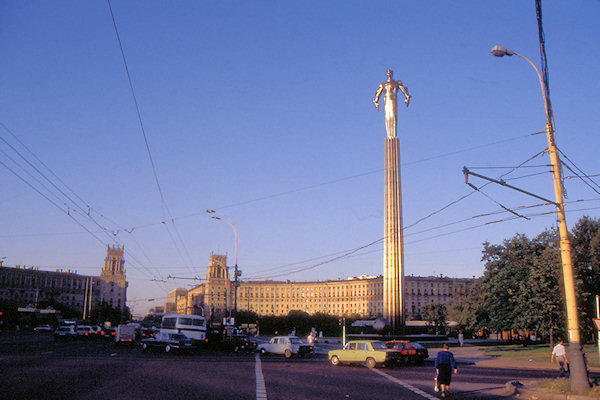 |
|||||
Present-day Moscow emerged as a trading post near the confluence of the Moscow and Yauza rivers.
Beginning in 1236, Eastern Europe was overwelmed by the ferocius Golden Horde; a Mongol-led army
of nomadic tribesmen. The Mongols introduced themselves to Moscow by burning the city to the ground and
killing the governor. The Golden horde was mainly interested in tribute, and Moscow was conventiently
situated to monitor the river trade and road traffic.
In 1480 Ivan III, called the Great faced down the Mongols. To celebrate his successes Ivan
complete renovate the fortress. The Kremlin's famous thick walls and imposing watchtowers were constructed
at this time.
In 1712 Moscow was superseded as capital of the Russian empire by St. Petersburg. Two hundred years later
the New Soviet governement moved back to Moscow and declared Moscow the de facto capital.
Moscow lies in the European part of the Soviet Union; which extends eastward into Asia ( In modern times
the Urals have been regarded as the boundery between Europe and Asia)
the Bell-tower of Ivan the Great or the Palce of Facets. But we have to install ourselves here for a long period.
The close daily contact between two historic poles, between two irreconcible cultures, was both astonishing and amusing.
Driving past Nicholas 's palace on the wooden paving, I would occasionaly glance over at the Emperior Bell and the Emperion Cannon.
All the barbarism of Moscow glared at me from the hole in the bell and mouth of the cannon.
Here Hamlet would have cried out.
"The time is out of joint; O cursed spite, that ever i was born to set it right!"
But there was nothing of Hamlet about us ........
Lev Trotsky (1879 - 1940)
Red Square
With an average length of 400m and average breath of 150m, the Red Square is not only of Moscow but
of the whole Soviet Union.
Since the time of Ivan III this has been the scene of great public events, mainly political
- rallies, demonstrations and processions.
Most of thenorth-east side of Red Squere is occupied by the GUM Departement store, facing the Lenin
Mausoleum and the tombs of prominent Soviet citizens below the Kremlin Walls.
At the south end of the square is St Basil's cathedral, near wich the German Cessna pilot Mathias Rust
landed in 1987.
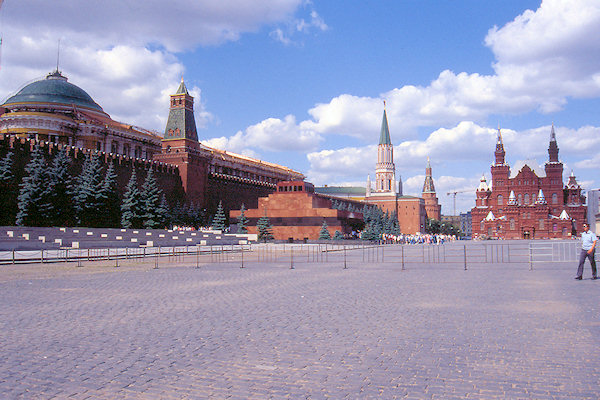 |
|||||
Council of Ministers Building
The Council of Ministers Building, formerly the Senate and from 1918 the seat of the Soviet Goverment, is
a prominent landmark with its huge green dome topped by the national flag.
The senate was build between 1776 and 1788 to the design of Matvey F. Kazakov.
Lenin Mausoleum
Even visitors who are against Lenin or indifferent to him will find it worth while, for the sake of
experience, to join the queue - sometimes apparently endless, particulary in summer - and go down into the
air-conditioned vault in which the embalmed body of the founder of the Soviet States lies in a glass
coffin.
Historical Museum
The Historical Museum, first opened in 1883, is the largest and most important museum devoted to the history
of the peoples of the Soviet Union from prehistoric times to the present day.
It's 44.000 exhibits, in forty-eight rooms, illustrate and document the history of Russia and the Soviet
Union from the Palaeolithic period, Koevan Russia, the dominance of the Golden Horde and the beginning of
the principality of Moscow to the centralised state, the cultural history of Russia in the 17th-19th century
and the Communist movement centered on Lenin.
GUM Department Store
The Gosudarstvenny Universainy Magazin or GUM was built between 1888 and 1894. Restored in the 1950's,
this huge glass-roofed complex (252m long by 90m across) house 150 sepeate shops with attract some 400.000
customers every day.
St Basil's Cathedral
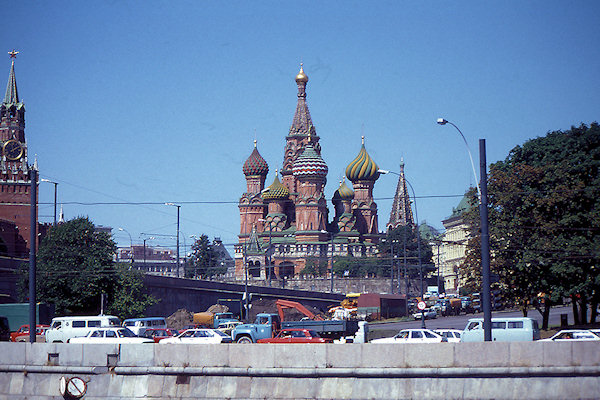 |
|||||
The church was originally built by Ivan the Terrible in 1555-1561 as the Cathedral of the Intercession of the Virgin to commemorate the capture of Kazan, capital of the khanate of Kazan.
According to the chronicier the architects of the cathedral, Postnik and Barma, were sent to
Ivan tyhe Terrible by God. The story that the Tsar had them blinded after the building was completed,
however, is no more than a legend, for in 1588, four years after Ivan's death, Postnik and Marma added
the chapel at the north-east corner of the cathedral housing the tomb of the holy fool Basil
(Vasily)
The holy fools were itinerent ascetics who enjoyed great popularity among the ordinary people of Russia,
many of them being revered as saints.
The holy fool Basil the Blessed was well known for his fearless denunciation of Ivan the Terrible's cruelties;
and when, after Ivan's death, his chapel was built on to the cathedral the name of the chapel gradually
came to be applied to the whole cathedral.
Kremlin
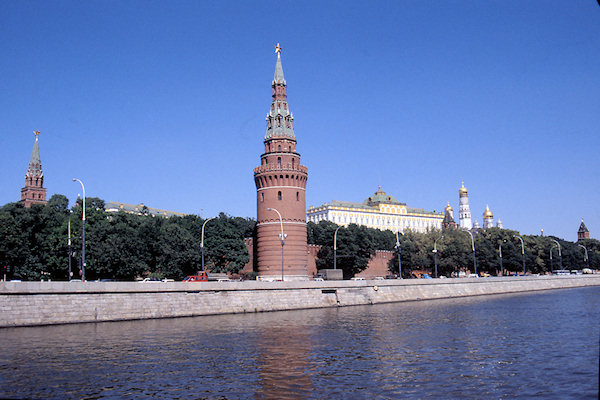 |
|||||
A citadel looming over Moscow from its commanding position 40m above the River Moskva, with the city's
main streets radiating from it in all directions; a stronghold in the form of an irregular quadrilaterlal
with an area of 28 hectares; palaces and cathedrals, enclosed within a wall 2.235m long, up to 19m high and
up to 6,5m thick; a fortress ringed by twenty towers and gates: the Kremlin is the heart of Moscow, the soul
of Russia, once the seat of the highest authority - over whom, in the words of a Russian proverb, there was
only God - and still the centre of governement.
The earliest fortified structure is mentioned in 1156, in the reign of Yuri dolgoruk, who is regarded
as the founder of Moscow.
The years from 1474 to about 1530, during the reigns of Ivan III (the Great) and his son
Vasily III, were a period of great building activity which largely gave the Kremlin its present
appearance.
The post-Revolutionary period has been mainly concerned with restoration and renovation work in the Kremlin.
This work has restored the Kremlin, not perhaps to its old splendour but to a new splendour which it has
known for centuries.
Kremlin (The Cathedrals)
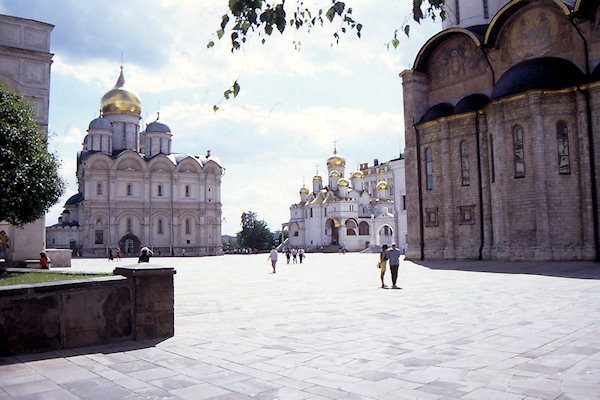 |
|||||
Cathedral of the Archangel Michael
The Cathedral of the Archangel Michael, built in 1506-1508 was the burial church of the Tsars. Here all
the Princes, Grand Princes and Tsars from Ivan Kalita onwards had their last resting-place.
After st Petersburg became the capital in 1712 the Tsars and emperors from Peter the Great onwards
were buried in the cathedral in the Peter and Paul Fortress.
Cathedral of the Annunciation
The Cathedral of the Annunciation with its nine gilded domes is the smallest of the three main Kremlin
cathedrals, but the decoration of the interior (in particular teh freascoes and icons) makes it one of the
great treasures of Moscow.
The cathedral was built in 1484-1489 by a team of builders from Pskov as the Court church of Grand Prince
Ivan III. It was connected by a passage at gallery level with the palace of the Grand Prince and later with
the Tsar's residence. The passage still leads from the Gallery into the Great Kremlin Palace, which
immediately adjoins the cathedral.
Cathedral of the Dormitition
The Cathedral of Dormition of the Virgin is the largest and most historic of the cathedrals in the Kremlin.
Here Princes, Grand princes and Tsars were crowned by the Metropolitian or Patriarch, here Metropolitians
and Patriarchs were enthroned and buried, and here many a chapter in the history of Moscow and of Russia
began or was concluded. From its completion in 1479 until the 17th century it provided an unmachchable
model for all cathedral-building in Russia.
Church of the Deposition of the Virgin's Robe
In front of the eleven domes of the Terem Palace is the Church of the Deposition of the Virgin's Robe,
with a single dome. It was built in 1484-1485 by the Pskov architects. The church, which was linked by a
staircase with the Patriarch's Palace, served as the domestic chapel of the Metropolitians and
Patriarchs.
Exhibition of Economic Achievements of the USSR
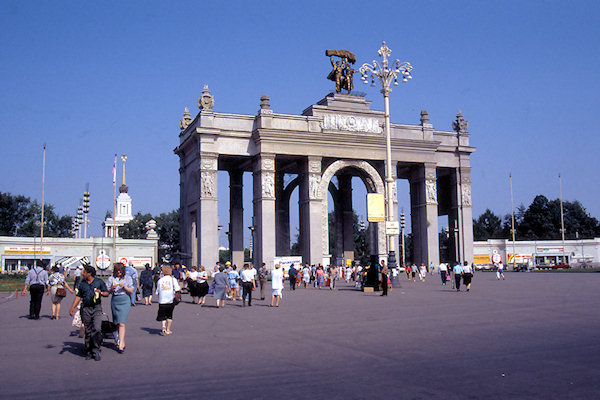 |
|||||
Here, within an area of some 310 hectares, are displayed some 100.000 items, constantly being changed,
representing the latest achievements of soviet industry, science and culture, transport and building.
Halls of particular interest are the "Cosmos" hall witj models of carrier rockets and space-ships,
and the "Mechanical Engineering" hall displaying the latest in Soviet industrial robots.
To see even a small part of this gigantic exhibition a full morning or afternoon should be set aside.
A good way of getting a general impression is to take a trip on one of the elctric trams which run
half-hour sightseeing tours.
Metro Stations
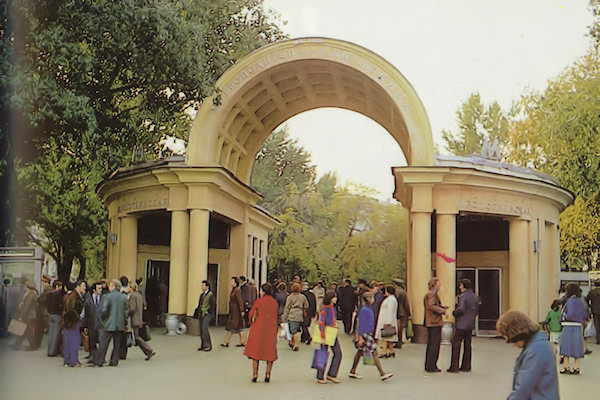 |
|||||
When Moscow's first Metro line, 11,2km lomg with thirteen stations, opened on 15 may 1935 passengers
found themselves in surroundings very different from other buildings in the capital - palatial stations,
spacious halls with chandeliers, huge concourses decorated with mosaics, constructed by an army of workers,
artists and engeneers under the direction of Nikita S. Khruschov, then the city's Party Chief, with
a lavish use of 70.000 sq.m of multi-coloured marble, precious metals, bronze, mosaics, gold and glass.
These first stations, planned by Stalin as prestige and show buildings, set a standard which designers of
subsequent stations sought to maintain.
Although the sumtuous decoration of Stalinist times is no longer in favour, Moscow's Metro must be the most
luxurious underground railway system in the world.